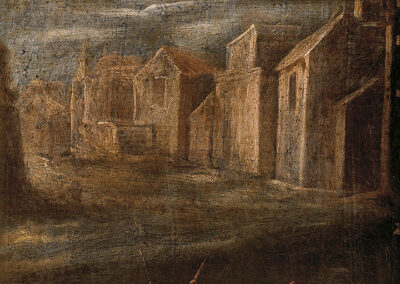This small square, attributed to Juan de Valdés Leal, visually narrates the central theme of the three main themes in which, immediately after the surrender of the fortress of La Mamora on 30 April 1681, the story of the captivity and rescue of the image of Jesus the Nazarene was organised in the accounts of events and in the chronicles of the Trinitarian order (J. García Bernal, 2011, pp. 20-35). Situated between the betrayal of the governor of the fortress who, to save his life and property, handed over the sacred effigy of the Nazarene to the infidels and the subsequent rescue of the image by the Trinitarian order, the central theme of all these texts, printed between 1681 and 1682, is the one represented in this painting: the humiliations suffered in Meknes by the image of the Nazarene, transformed into a captive. This is already the iconography that appears in a ".First real relationship..."published in 1682 by the Trinitarian order in which the image is described as it is represented in this painting".First of all, the Moors captured a figure of Jesus of Nazareth, of natural stature, very beautiful. with their hands folded in front of themto immediately describe the scene that visually conveys this canvas "...".the king ordered the most beautiful bust of Jesus of Nazareth to be dragged and thrown down a dunghill, mocking and mocking the beautiful portrait...."
This little square, which, because of its size and its "blur"It seems to be a preparatory sketch for a larger canvas, and must have been commissioned almost at the same time as the aforementioned accounts of events and chronicles and also the exhibition of the prodigious image in a chapel, carved for the purpose, in one of the convents that housed the palace of the Duke of Medinaceli on the Paseo del Prado, a location that would give its name to this new invocation of a captive dressed in rich clothes: Jesús de Medinaceli.


